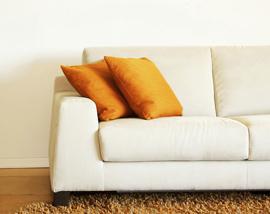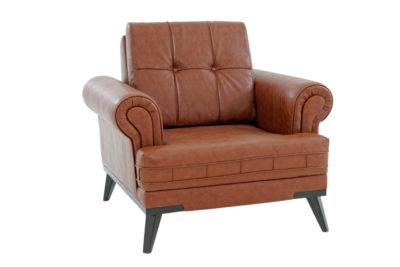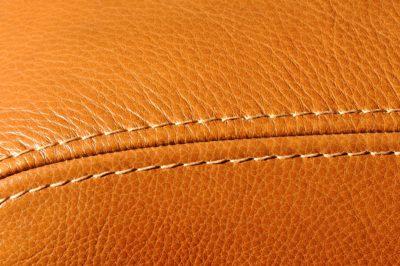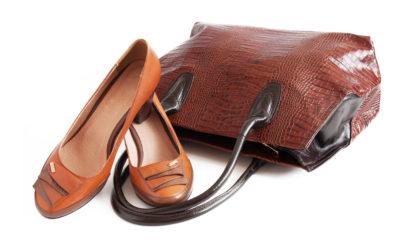
Leather is one of the best natural materials. After treatment, leather can be used for manufacturing many types of items, because it is long-lasting and has exceptional wear resistance. Bovine hides are generally used for furniture upholstery, and often also for shoes, bags, and accessories. As different leather types are vastly different from one another, they require particular care.
Caring for leather furniture with Softcare products
First, the surface of the leather furniture is cleaned with a cleaner, and allowed to dry thoroughly. Then, a protective treatment will be done, and after that has dried, a very thin layer of wax is added. Done a few times a year, waxing will keep the leather supple, and prevent drying and cracking.
Phase 1: cleaning
Leather furniture must be cleaned on a regular basis, as it accumulates dust, dirt, tobacco smoke, grease, etc. There is a slow build-up of these in the pores of the leather, showing up as a layer of dirt that must be removed regularly.
 Depending on use, it is sufficient to vacuum leather furniture every week or two, with a textile nozzle, and to wipe it with a soft cloth dabbed in Softcare Leather Cleaner or Leather Cleaner Pro. The cleaner will be absorbed into the pores of the leather, pushing dirt out and deep-cleaning the leather. Never use dish-washing detergent to clean leather, as it will also remove the leather’s own grease, and the leather surface will dry and start cracking easily. You can also clean faux leather and plastic with Softcare cleaners.
Depending on use, it is sufficient to vacuum leather furniture every week or two, with a textile nozzle, and to wipe it with a soft cloth dabbed in Softcare Leather Cleaner or Leather Cleaner Pro. The cleaner will be absorbed into the pores of the leather, pushing dirt out and deep-cleaning the leather. Never use dish-washing detergent to clean leather, as it will also remove the leather’s own grease, and the leather surface will dry and start cracking easily. You can also clean faux leather and plastic with Softcare cleaners.
Phase 2: protection
Leather items should be protected against dirt and moisture immediately after their purchase using Softcare Leather Protector or the water-based Softcare Leather Protector. The polymers in the leather protector form a network of molecules in the pores of the leather, preventing water- and grease-based dirt from becoming absorbed beyond the surface. The protection does not affect the breathability or appearance of the leather.
Remember that Bycast, Pull Up and Bonded leather, as well as faux leather, have been coated with plastic. These can never be protected with the normal Softcare Leather Protector as it leaves grey stains on a plastic surface. For these surfaces, use the water based protector. Always test it first, in an invisible area, to check the surface type.

The protection is done on a dry, clean surface before the application of the leather balsam. Work in a well-ventilated room. Spray the leather protector on a dry, clean surface from a distance of about 15 cm so that the surface gets slightly damp. Even out any drip marks with a sponge or a soft cloth, and let air-dry completely before use. Let the protected leather dry for 48 hours before applying the leather balsam.
Aniline leather and thinly-coated semi-aniline leather, in particular, require protection. Softcare Leather Protector is also well suited for suede and nubuck surfaces. Follow the manufacturer’s care instructions.
It is easy to remove dirt from a protected surface, and the furniture will remain looking as new. It is recommended to repeat the protection process every 2–4 years, depending on the use. The efficiency of the protection can be tested with a drop of water: if the droplet remains on the surface, the protection is still working.
Phase 3: waxing
Leather requires regular waxing. The open, breathable structure of leather lets the natural greases and moisture of the material evaporate, so the moisture and grease balance must be maintained with regular treatment, 2–3 times a year. Excessive drying can lead to the hardening of the surface, the seat bags becoming visible, and later to cracking and other damage. The damage is usually permanent. Therefore, leather must be kept supple with wax.
Softcare Leather Balsam contains natural oils and moisturisers that leather needs. It is applied with a sponge in a very thin layer onto the leather surface, using circular motion. Only apply as much as the leather can absorb at any one time. The excess wax can be wiped off with a dry, soft cloth. Softcare Leather Balsam is very economical.
 Aniline and other leathers with a thin top coating may darken when waxed. This is caused by the moisturising effect of the oils, but the original colour will return in a few days when the balsam has been absorbed. If you are unsure about the end result, test the product first in an invisible area. It is not necessary to wax faux leather or polyurethane-coated Bycast, Pull Up and bonded leather.
Aniline and other leathers with a thin top coating may darken when waxed. This is caused by the moisturising effect of the oils, but the original colour will return in a few days when the balsam has been absorbed. If you are unsure about the end result, test the product first in an invisible area. It is not necessary to wax faux leather or polyurethane-coated Bycast, Pull Up and bonded leather.
Did you know that in addition to caring for and protecting furniture, you can also use Softcare leather care products for bags, leather accessories, shoes, saddles, and other recreational leather equipment like dog harnesses?

